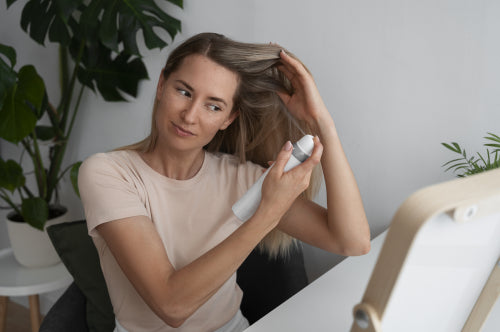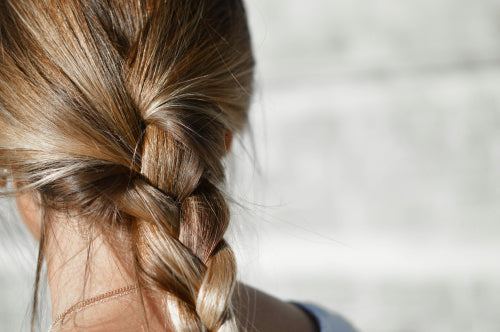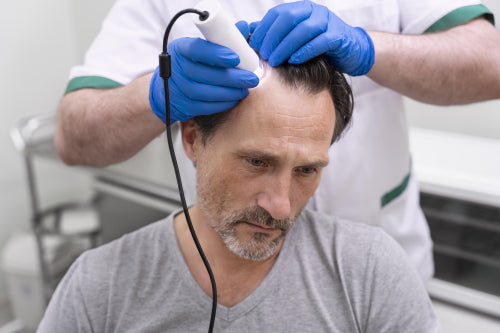Quick Listen:
Hair loss is a universal concern that transcends age, gender, and cultural boundaries. For many, the thought of losing one's hair is more than just a cosmetic issue; it's a reflection of health and well-being. In this quest for a full head of hair, low-level laser therapy (LLLT) has emerged as a promising treatment option. But how effective is it, and most importantly, is it safe?
Background on Low-Level Laser Therapy
Low-level laser therapy, also known as photobiomodulation, involves the application of low-intensity light to stimulate hair follicles and promote hair growth. This non-invasive treatment has gained significant attention due to its non-drug modality and relatively low cost compared to surgical options like hair transplants.
Mechanisms Behind LLLT's Benefits
The principles behind LLLT are rooted in the concept that low-intensity light can influence biological processes without causing thermal damage. This therapy works by enhancing cellular processes, such as increasing ATP production and improving blood flow to targeted areas. The stimulation of dormant hair follicles prolongs the anagen phase (the active growth phase), increases rates of proliferation in active anagen hair follicles, and inhibits premature catagen development.
Scientific Studies on LLLT for Hair Loss
Numerous scientific studies have investigated the efficacy of LLLT for treating hair loss. A study published in News Medical highlighted that low-level laser treatment can stimulate hair follicles and promote hair growth by increasing the length of the anagen phase. Another study found that LLLT enhances hair density and reduces shedding, suggesting its potential as a viable treatment option for androgenetic alopecia (AGA). Additionally, research indicates that LLLT may be beneficial for chemotherapy-induced hair loss, a condition affecting many cancer patients undergoing treatment.
Clinical Evidence and Outcomes
Clinical trials provide crucial evidence regarding the safety and efficacy of LLLT for hair loss. A systematic review of clinical trials found that while there is considerable variability in study design and outcomes, the majority of studies indicate positive effects on hair growth when using LLLT. For instance, a clinically controlled study demonstrated a 39% increase in hair growth, concluding that LLLT significantly improved hair count.
Safety Considerations
While LLLT appears to be generally safe, there are potential risks to consider. One primary concern is the potential for eye damage due to direct exposure to the laser beam. It is crucial that users wear protective eyewear during treatment sessions to avoid this risk. Additionally, some individuals may experience minor side effects such as redness or irritation at the treatment site, although these are typically temporary and resolve on their own.
Regulatory Status and Standardization
The regulatory status of LLLT devices varies by country, with some jurisdictions requiring FDA clearance or CE marking for marketing approval. In the United States, the FDA has cleared several LLLT devices for hair loss treatment under specific indications and conditions. However, standardization in the industry remains a challenge, with varying levels of intensity and duration reported across different devices.
User Experience and Practical Implementation
Beyond scientific research lies the practical application of LLLT for hair loss. Users report mixed experiences with varying degrees of success. Some individuals achieve noticeable improvements in hair density and reduced shedding after consistent use over several months. Others find the treatment ineffective or experience minor side effects that discourage continued use.
Ethical Considerations in Marketing LLLT Devices
The marketing of LLLT devices must adhere to ethical standards to avoid misleading consumers about their potential benefits. Advertisements should clearly state that individual results may vary and provide balanced information about both positive and negative aspects of treatment. Manufacturers should also ensure that their products meet safety standards and comply with regulatory requirements to maintain consumer trust.
Low-level laser therapy holds promise as a non-invasive treatment option for hair loss, backed by a significant body of scientific research. While its potential benefits are compelling, it is crucial to approach this therapy with caution and recognize both its limitations and potential risks. As with any medical intervention, consulting with a healthcare professional before starting treatment is essential. By providing balanced information about this emerging therapy, we can empower consumers to make informed decisions about their healthcare options.
In summary, LLLT represents a novel approach to addressing hair loss that requires thorough evaluation and consideration. As the field continues to evolve with ongoing research and improved device technology, it is imperative that we prioritize both safety and efficacy to ensure that this therapy lives up to its full potential as a viable solution for those struggling with alopecia.
By exploring both the scientific underpinnings and practical implications of low-level laser therapy, we can better understand its role in addressing hair loss while maintaining a nuanced perspective that acknowledges both its promise and potential pitfalls.
Additional Insights
- Mechanisms of Action: LLLT may act through direct or indirect increases in proliferative activity within the hair follicle epithelial matrix, potentially accelerating keratinocyte and fibroblast mitosis by generating reactive oxygen species (ROS) and antioxidants.
- Combination Therapy: Combining LLLT with topical minoxidil solution and oral finasteride may enhance hair regrowth synergistically, although more controlled large studies are needed to confirm this.
- Variability in Results: Individual results can vary significantly, emphasizing the need for personalized treatment approaches based on individual responses to therapy.
Low-level laser therapy offers a promising step toward reclaiming your natural beauty. While its long-term effects are still being studied, the existing evidence paints a picture of safety and efficacy. For those struggling with hair loss, LLLT provides hopea beacon of light that can illuminate the path to thicker, healthier hair.
Disclaimer: This Helpful Resources content is for informational purposes only and should not be considered medical, health or wellness advice. Please consult a medical, health or wellness professional before making any choices or decisions.
Hair loss eroding your confidence? Don't let it define you. My Hair Smart blends Ayurvedic wisdom with scientific innovation to target root causes of thinning hair. Our natural, clinically-proven formulas nourish your scalp and stimulate growth without harsh chemicals. Dont wait another day. Reclaim your hair and your confidence with My Hair Smart today, Shop Now!







Leave a comment
This site is protected by hCaptcha and the hCaptcha Privacy Policy and Terms of Service apply.